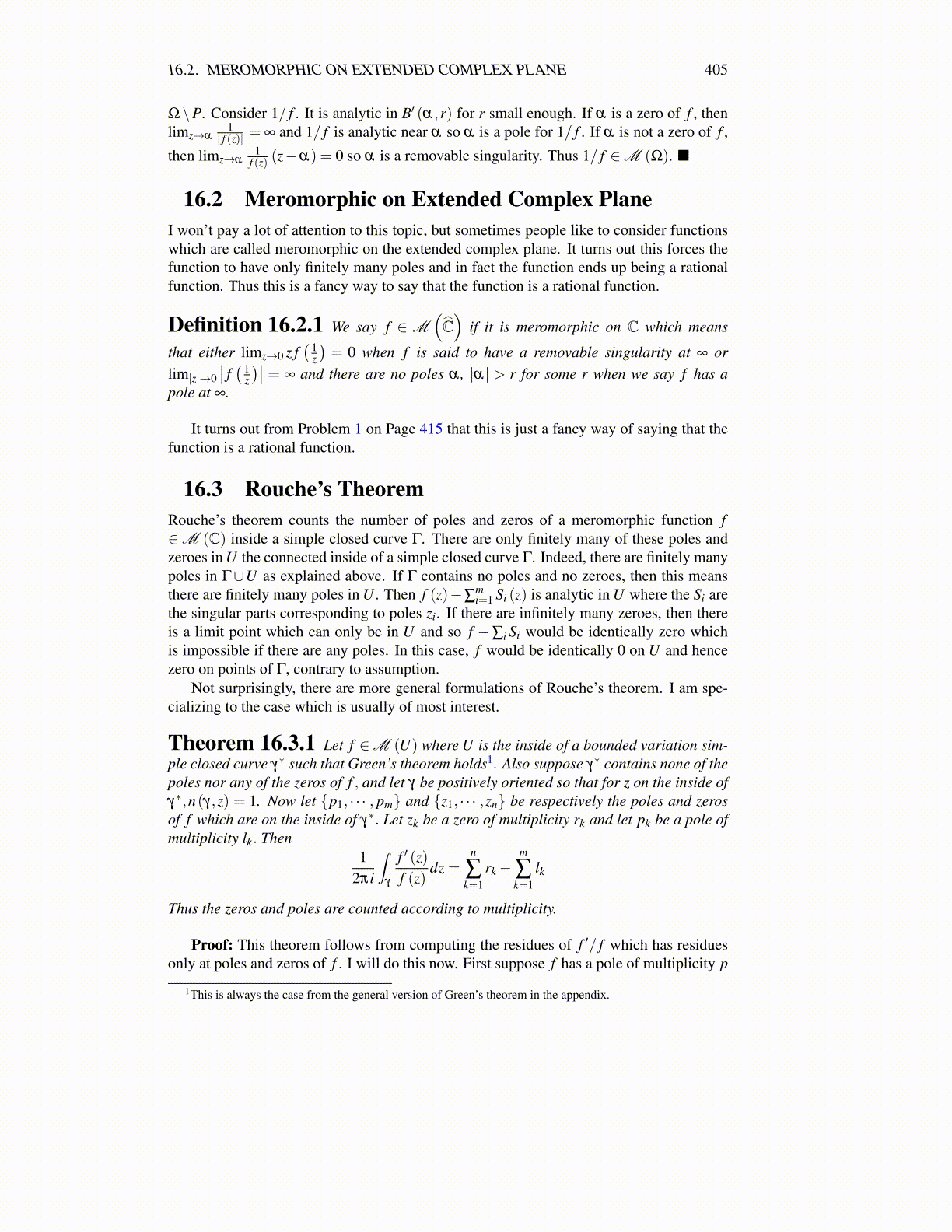
16.2. MEROMORPHIC ON EXTENDED COMPLEX PLANE 405
Ω\P. Consider 1/ f . It is analytic in B′ (α,r) for r small enough. If α is a zero of f , thenlimz→α
1| f (z)| = ∞ and 1/ f is analytic near α so α is a pole for 1/ f . If α is not a zero of f ,
then limz→α1
f (z) (z−α) = 0 so α is a removable singularity. Thus 1/ f ∈M (Ω). ■
16.2 Meromorphic on Extended Complex PlaneI won’t pay a lot of attention to this topic, but sometimes people like to consider functionswhich are called meromorphic on the extended complex plane. It turns out this forces thefunction to have only finitely many poles and in fact the function ends up being a rationalfunction. Thus this is a fancy way to say that the function is a rational function.
Definition 16.2.1 We say f ∈M(Ĉ)
if it is meromorphic on C which means
that either limz→0 z f( 1
z
)= 0 when f is said to have a removable singularity at ∞ or
lim|z|→0∣∣ f ( 1
z
)∣∣ = ∞ and there are no poles α , |α| > r for some r when we say f has apole at ∞.
It turns out from Problem 1 on Page 415 that this is just a fancy way of saying that thefunction is a rational function.
16.3 Rouche’s TheoremRouche’s theorem counts the number of poles and zeros of a meromorphic function f∈M (C) inside a simple closed curve Γ. There are only finitely many of these poles andzeroes in U the connected inside of a simple closed curve Γ. Indeed, there are finitely manypoles in Γ∪U as explained above. If Γ contains no poles and no zeroes, then this meansthere are finitely many poles in U . Then f (z)−∑
mi=1 Si (z) is analytic in U where the Si are
the singular parts corresponding to poles zi. If there are infinitely many zeroes, then thereis a limit point which can only be in U and so f −∑i Si would be identically zero whichis impossible if there are any poles. In this case, f would be identically 0 on U and hencezero on points of Γ, contrary to assumption.
Not surprisingly, there are more general formulations of Rouche’s theorem. I am spe-cializing to the case which is usually of most interest.
Theorem 16.3.1 Let f ∈M (U) where U is the inside of a bounded variation sim-ple closed curve γ∗ such that Green’s theorem holds1. Also suppose γ∗ contains none of thepoles nor any of the zeros of f , and let γ be positively oriented so that for z on the inside ofγ∗,n(γ,z) = 1. Now let {p1, · · · , pm} and {z1, · · · ,zn} be respectively the poles and zerosof f which are on the inside of γ∗. Let zk be a zero of multiplicity rk and let pk be a pole ofmultiplicity lk. Then
12πi
∫γ
f ′ (z)f (z)
dz =n
∑k=1
rk−m
∑k=1
lk
Thus the zeros and poles are counted according to multiplicity.
Proof: This theorem follows from computing the residues of f ′/ f which has residuesonly at poles and zeros of f . I will do this now. First suppose f has a pole of multiplicity p
1This is always the case from the general version of Green’s theorem in the appendix.